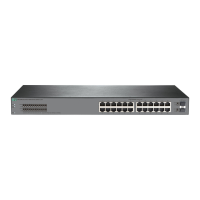52
Procedure
1. Enter system view.
system-view
2. Configure the DHCP server to back up the bindings to a file.
dhcp server database filename { filename | url url [ username username
[
password { cipher | simple } string ] ] }
By default, the DHCP server does not back up the DHCP bindings.
With this command executed, the DHCP server backs up its bindings immediately and runs
auto backup.
3. (Optional.) Manually save the DHCP bindings to the backup file.
dhcp server database update now
4. (Optional.) Set the waiting time after a DHCP binding change for the DHCP server to update the
backup file.
dhcp server database update interval interval
By default, the DHCP server waits 300 seconds to update the backup file after a DHCP binding
change. If no DHCP binding changes, the backup file is not updated.
5. (Optional.) Terminate the download of DHCP bindings from the backup file.
dhcp server database update stop
This command only triggers one termination.
Enabling client offline detection on the DHCP
server
About client offline detection on the DHCP server
The client offline detection feature reclaims an assigned IP address and deletes the binding entry
when the ARP entry for the IP address ages out.
Restrictions and guidelines
The feature does not function if an ARP entry is manually deleted.
Procedure
1. Enter system view.
system-view
2. Enter interface view.
interface interface-type interface-number
3. Enable client offline detection.
dhcp client-detect
By default, client offline detection is disabled on the DHCP server.
Configuring address pool usage alarming
About address pool usage alarming
Perform this task to set the threshold for address pool usage alarming. When the threshold is
exceeded, the system sends log messages to the information center. According to the log
information, you can optimize the address pool configuration. For more information about the
information center, see Network Management and Monitoring Configuration Guide.

